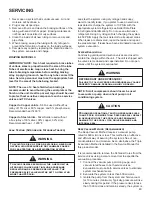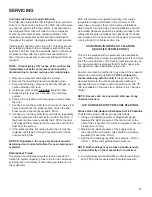
SERVICING
56
Checking Restricted Liquid Line
When the system is operating, the liquid line is warm to the
touch. If the liquid line is restricted, a definite temperature
drop will be noticed at the point of restriction. In severe
cases, frost will form at the restriction and extend down the
line in the direction of the flow.
Discharge and suction pressures will be low, giving the
appearance of an undercharged unit. However, the unit
will have normal to high subcooling.
Locate the restriction, replace the restricted part, replace
drier, evacuate and recharge.
Overcharge of Refrigerant
An overcharge of refrigerant is normally indicated by an
excessively high head pressure.
An evaporator coil, using an expansion valve metering
device, will basically modulate and control a flooded
evaporator and prevent liquid return to the compressor.
An evaporator coil, using a capillary tube metering device,
could allow refrigerant to return to the compressor under
extreme overcharge conditions. Also with a capillary tube
metering device, extreme cases of insufficient indoor air
can cause icing of the indoor coil and liquid return to the
compressor, but the head pressure would be lower.
There are other causes for high head pressure which may
be found in the “Service Problem Analysis Guide.”
If other causes check out normal, an overcharge or a
system containing non-condensables would be indicated.
If this system is observed:
1. Start the system.
2. Remove and capture small quantities of gas from the
suction line dill valve until the head pressure is reduced
to normal.
3. Observe the system while running a cooling
performance test. If a shortage of refrigerant is
indicated, then the system contains non-condensables.
Non-Condensables
If non-condensables are suspected, shut down the system
and allow the pressures to equalize. Wait at least 15
minutes. Compare the pressure to the temperature of the
coldest coil since this is where most of the refrigerant will
be. If the pressure indicates a higher temperature than
that of the coil temperature, non-condensables are present.
Non-condensables are removed from the system by first
removing the refrigerant charge, replacing and/or installing
liquid line drier, evacuating and recharging.
Checking Compressor Efficiency
The reason for compressor inefficiency is broken or
damaged scroll flanks on Scroll compressors, reducing the
ability of the compressor to pump refrigerant vapor. The
condition of the scroll flanks is checked in the following
manner.
1. Attach gauges to the high and low side of the system.
2. Start the system and run a “Cooling Performance Test.
If the test shows:
A. Below normal high side pressure.
B. Above normal low side pressure.
C.
Low temperature difference across coil.
D. Low amp draw at compressor.
And the charge is correct. The compressor is faulty –
replace the compressor.
Compressor Burnout
When a compressor burns out, high temperature develops
causing the refrigerant, oil and motor insulation to
decompose forming acids and sludge.
If a compressor is suspected of being burned-out, attach
a refrigerant hose to the liquid line dill valve and properly
remove and dispose of the refrigerant.
NOTICE
Violation of EPA regulations may result in fines
or other penalties.
Now determine if a burn out has actually occurred.
Confirm by analyzing an oil sample using a Sporlan Acid
Test Kit, AK-3 or its equivalent.
Remove the compressor and obtain an oil sample from the
suction stub. If the oil is not acidic, either a burnout has not
occurred or the burnout is so mild that a complete clean-up
is not necessary.
If acid level is unacceptable, the system must be cleaned
by using the clean-up drier method.
CAUTION
Do not allow the sludge or oil to contact the
skin. Severe burns may result.
NOTE: The Flushing Method using R-11 refrigerant
is no longer approved by Amana® Brand Heating-
Cooling.
Содержание ASXC16
Страница 4: ...PRODUCT IDENTIFICATION 4 ...
Страница 5: ...PRODUCT IDENTIFICATION 5 ...
Страница 70: ...SERVICING 70 PCBHR104 PCBHR105 ...
















































